from ESPN http://ift.tt/1dPqUAn
Split the Universe
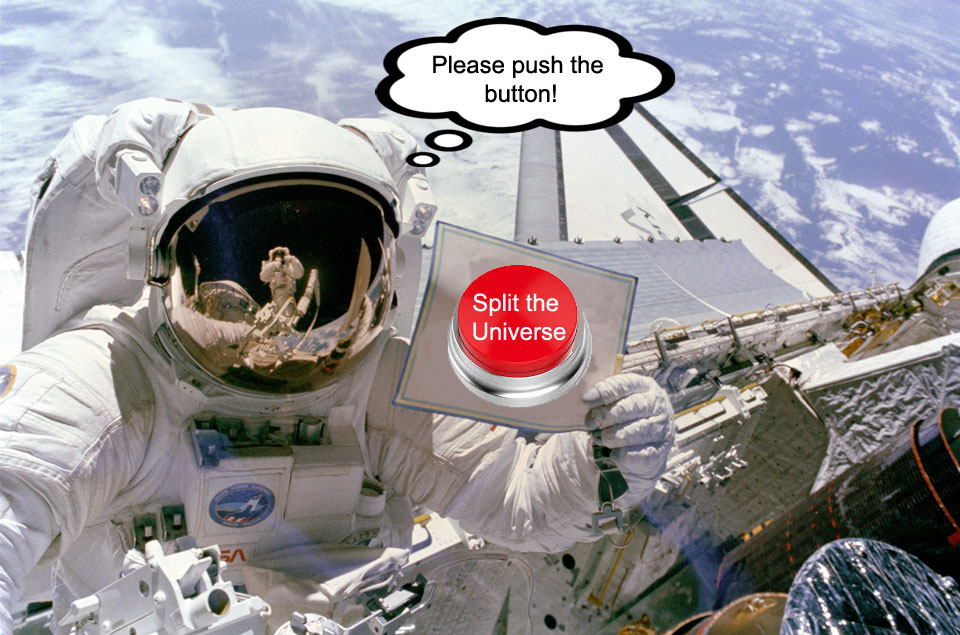
Just now, before you hit the button, two future universes are possible. After pressing the button, though, you will live in only one. A real-web version of the famous Schrödinger's cat experiment, clicking the red button in the featured astronaut image should transform that image into a picture of the same astronaut holding one of two cats -- one living, or one dead. The timing of your click, combined with the wiring of your brain and the millisecond timing of your device, will all conspire together to create a result dominated, potentially, by the randomness of quantum mechanics. Some believe that your personally-initiated quantum decision will split the universe in two, and that both the live-cat and dead-cat universes exist in separate parts of a larger multiverse. Others believe that the result of your click will collapse the two possible universes into one -- in a way that could not have been predicted beforehand. Yet others believe that the universe is classically deterministic, so that by pressing the button you did not really split the universe, but just carried out an action predestined since time began. We at APOD believe that however foolish you may feel clicking the red button, and regardless of the outcome, you should have a happy April Fool's Day. via NASA http://ift.tt/2oGyWqt
Dr. Nancy Grace Roman, Astronomer

Dr. Nancy Grace Roman is shown with a model of the Orbiting Solar Observatory (OSO) in 1962. She was the first Chief of Astronomy in the Office of Space Science at NASA Headquarters and the first woman to hold an executive position at NASA. She had oversight for the planning and development of programs including the Hubble Space Telescope. via NASA http://ift.tt/2ohUxc9
3D 67P
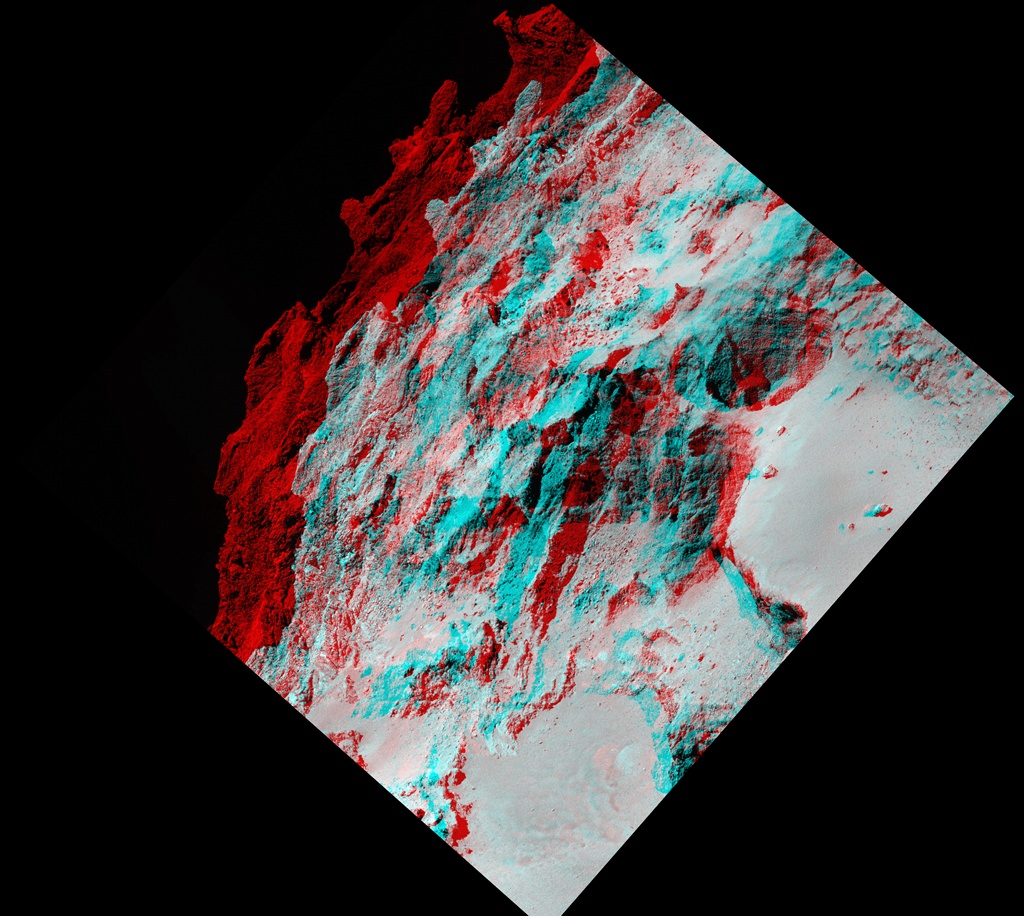
Get out your red/cyan glasses and gaze across the surface of Churyumov-Gerasimenko, aka Comet 67P. The stereo anaglyph was created by combining two images from the Rosetta spacecraft's narrow angle OSIRIS camera taken on September 22, 2014. Stark and jagged, the 3D landscape is found along the Seth region of the comet's double-lobed nucleus. It spans about 985 x 820 meters, pocked by circular ridges, depressions, and flattened areas strewn with boulders and debris. The large steep-walled circular pit in the foreground is 180 meters in diameter. Rosetta's mission to the comet ended in September 2016 when the spacecraft was commanded to a controlled impact with the comet's surface. via NASA http://ift.tt/2nnbvSz
Robotics Work on Space Station Set Up Thursday Spacewalk

The Pressurized Mating Adapter-3 (PMA-3) is in the grip of the International Space Station's Canadarm2 robotic arm during its relocation and attachment to the station's Harmony module on March 26,2017. A spacewalk by NASA astronauts Shane Kimbrough and Peggy Whitson, which began at 7:29 a.m., will finalize the PMA-3 cable connections on Harmony. via NASA http://ift.tt/2nzAyCU
Young Stars and Dusty Nebulae in Taurus
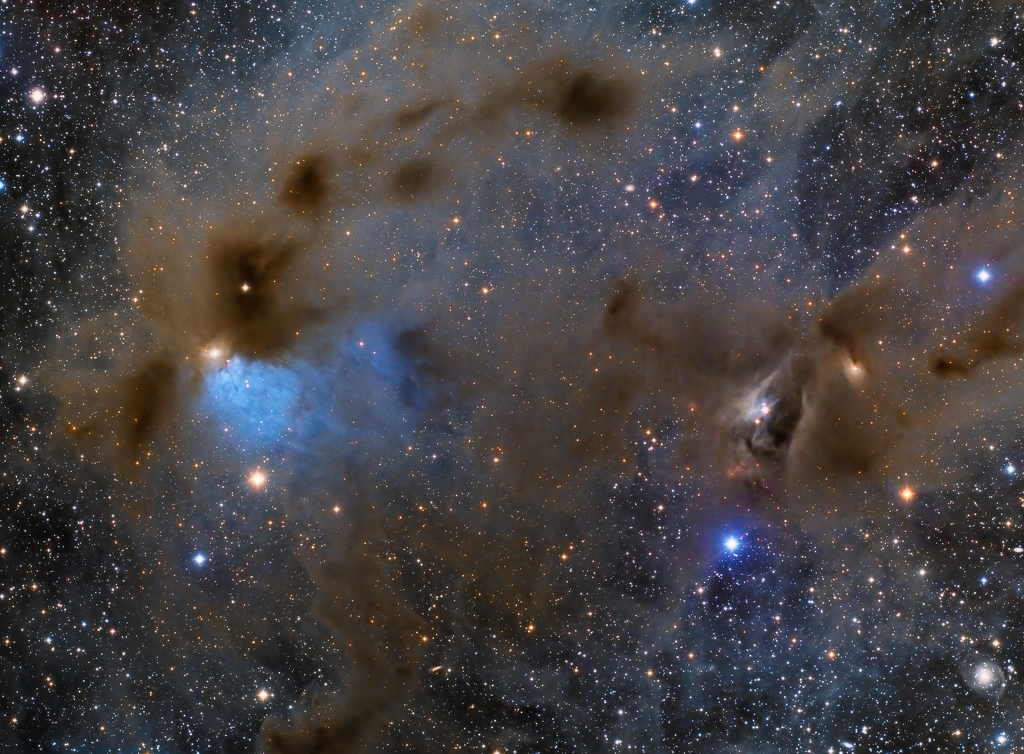
This complex of dusty nebulae lingers along the edge of the Taurus molecular cloud, a mere 450 light-years distant. Stars are forming on the cosmic scene. Composed from almost 40 hours of image data, the 2 degree wide telescopic field of view includes some youthful T-Tauri class stars embedded in the remnants of their natal clouds at the right. Millions of years old and still going through stellar adolescence, the stars are variable in brightness and in the late phases of their gravitational collapse. Their core temperatures will rise to sustain nuclear fusion as they grow into stable, low mass, main sequence stars, a stage of stellar evolution achieved by our middle-aged Sun about 4.5 billion years ago. Another youthful variable star, V1023 Tauri, can be spotted on the left. Within its yellowish dust cloud, it lies next to the striking blue reflection nebula Cederblad 30, also known as LBN 782. Just above the bright bluish reflection nebula is dusty dark nebula Barnard 7. via NASA http://ift.tt/2o9e3rJ
The Splitting of the Dunes

The mound in the center of this Mars Reconnaissance Orbiter image appears to have blocked the path of the dunes as they marched south (north is to the left in this image) across the scene. Smaller dunes run perpendicular to some of the larger-scale dunes, probably indicating a shift in wind directions in this area. via NASA http://ift.tt/2nAjle8
Nebula with Laser Beams
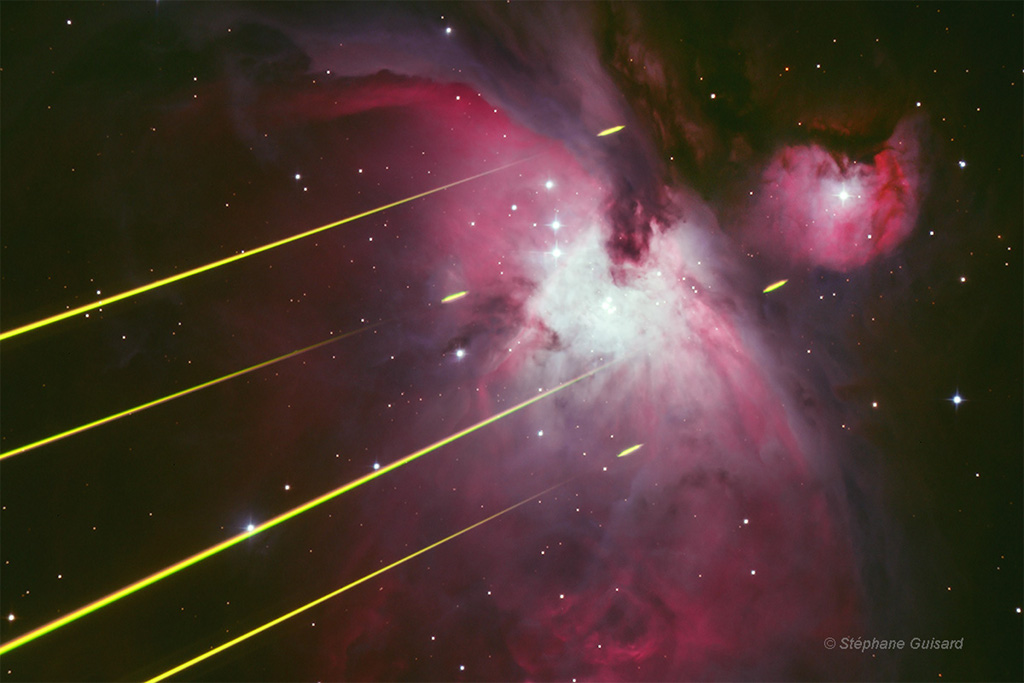
Four laser beams cut across this startling image of the Orion Nebula, as seen from ESO's Paranal Observatory in the Atacama desert on planet Earth. Not part of an interstellar conflict, the lasers are being used for an observation of Orion by UT4, one of the observatory's very large telescopes, in a technical test of an image-sharpening adaptive optics system. This view of the nebula with laser beams was captured by a small telescope from outside the UT4 enclosure. The beams are visible from that perspective because in the first few kilometers above the observatory the Earth's dense lower atmosphere scatters the laser light. The four small segments appearing beyond the beams are emission from an atmospheric layer of sodium atoms excited by the laser light at higher altitudes of 80-90 kilometers. Seen from the perspective of the UT4, those segments form bright spots or artificial guide stars. Their fluctuations are used in real-time to correct for atmospheric blurring along the line-of-sight by controlling a deformable mirror in the telescope's optical path. via NASA http://ift.tt/2nw3RIa
King of Wings Hoodoo under the Milky Way
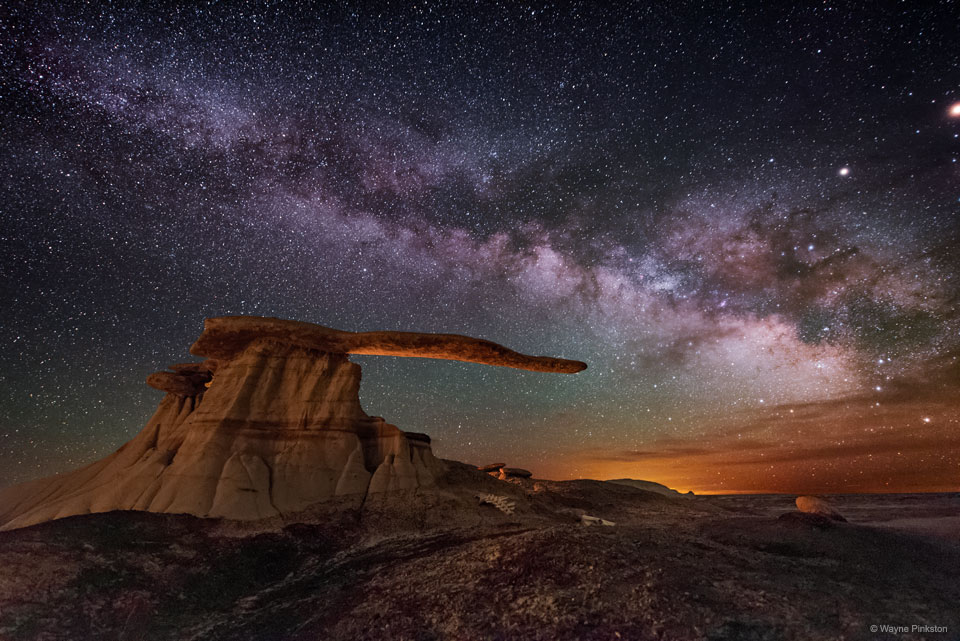
This rock structure is not only surreal -- it's real. The reason it's not more famous is that it is, perhaps, smaller than one might guess: the capstone rock overhangs only a few meters. Even so, the King of Wings outcrop, located in New Mexico, USA, is a fascinating example of an unusual type of rock structure called a hoodoo. Hoodoos may form when a layer of hard rock overlays a layer of eroding softer rock. Figuring out the details of incorporating this hoodoo into a night-sky photoshoot took over a year. Besides waiting for a suitably picturesque night behind a sky with few clouds, the foreground had to be artificially lit just right relative to the natural glow of the background. After much planning and waiting, the final shot, featured here, was taken in May 2016. Mimicking the horizontal bar, the background sky features the band of our Milky Way Galaxy stretching overhead. via NASA http://ift.tt/2mI4Fel
Final: Giants 10 Cubs 7. WP: SF D Law (4-2) LP: CHC P Johnson SV: SF A Suarez (0) (ESPN)
from ESPN http://ift.tt/1dPqUAn
Black Hole Accreting with Jet
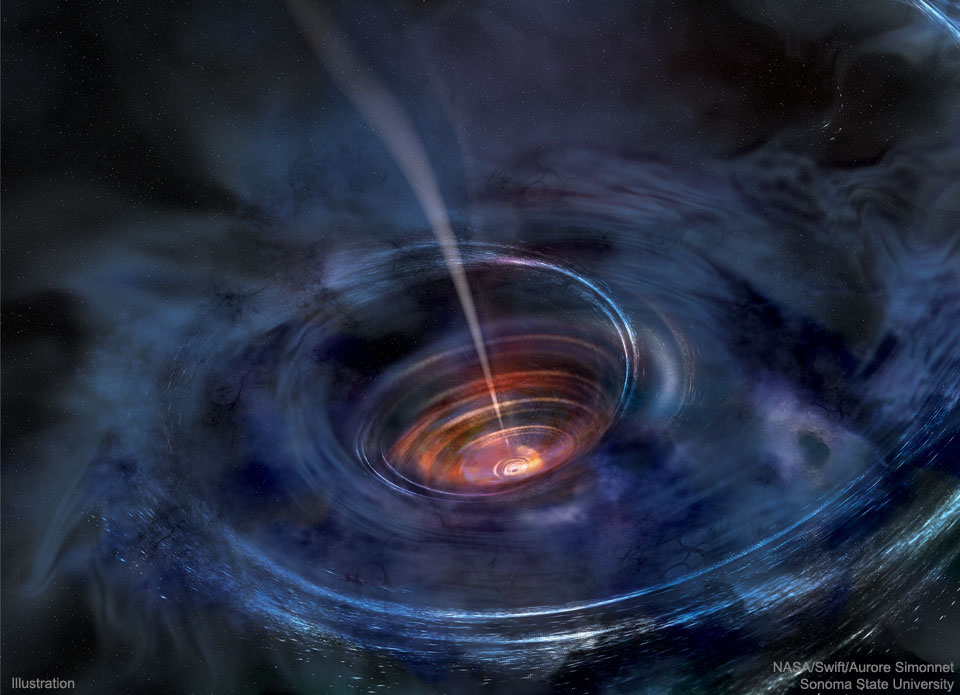
What happens when a black hole devours a star? Many details remain unknown, but recent observations are providing new clues. In 2014, a powerful explosion was recorded by the ground-based robotic telescopes of the All Sky Automated Survey for SuperNovae (ASAS-SN) project, and followed up by instruments including NASA's Earth-orbiting Swift satellite. Computer modeling of these emissions fit a star being ripped apart by a distant supermassive black hole. The results of such a collision are portrayed in the featured artistic illustration. The black hole itself is a depicted as a tiny black dot in the center. As matter falls toward the hole, it collides with other matter and heats up. Surrounding the black hole is an accretion disk of hot matter that used to be the star, with a jet emanating from the black hole's spin axis. via NASA http://ift.tt/2opv6BN
Expedition 50 Spacewalks Prepare Station for Arrival of Commercial Crew Spacecraft

Flight Engineer Thomas Pesquet of ESA is seen floating outside the International Space Station during a spacewalk. Pesquet and Expedition 50 Commander Shane Kimbrough of NASA conducted the six-hour-and-34-minute spacewalk on March 24, 2017. A second spacewalk, by Kimbrough and NASA astronaut Peggy Whitson, is scheduled for Thursday, March 30. via NASA http://ift.tt/2nwyygv
Final: Giants 14 Reds 2. WP: SF M Bumgarner (15-9) LP: CIN C Reed (0-7) (ESPN)
from ESPN http://ift.tt/1dPqUAn
Dark Spot and Jovian ‘Galaxy’

This enhanced-color image of a mysterious dark spot on Jupiter seems to reveal a Jovian “galaxy” of swirling storms. via NASA http://ift.tt/2o23lmK
Final: White Sox 4 Giants 3. WP: CHW B Smith (0-0) LP: SF N Ramirez (0-0) (ESPN)
from ESPN http://ift.tt/1dPqUAn
Final: Giants 8 Padres 7. WP: SF N Ramirez (0-0) LP: SD C Fisher (ESPN)
from ESPN http://ift.tt/1dPqUAn
Hubble Spots Two Interacting Galaxies Defying Cosmic Convention

Hubble spots two interacting galaxies some 60 million light-years away in the constellation of Leo. via NASA http://ift.tt/2mzfMG8
Dr. Ellen Ochoa on the Flight Deck of Shuttle Atlantis

On April 15, 2002, STS-110 Mission Specialist Ellen Ochoa works at the Remote Manipulator System controls on the aft flight deck of space shuttle Atlantis. Dr. Ochoa, a veteran astronaut, is currently the 11th director of Johnson Space Center. She became the first Hispanic woman to go to space when she served on the STS-56 mission. via NASA http://ift.tt/2mUXF97
Final: Giants 6 Brewers 4. WP: SF R Gomez LP: MIL C Torres (3-3) SV: SF A Suarez (0) (ESPN)
from ESPN http://ift.tt/1dPqUAn
Space Station View of Mount Etna Erupting

The Expedition 50 crew aboard the International Space Station had a nighttime view from orbit of Europe's most active volcano, Mount Etna, erupting on March 19, 2017. Astronaut Thomas Pesquet of ESA captured this image, writing, "Mount Etna, in Sicily. The volcano is currently erupting and the molten ava is visible from space, at night!" via NASA http://ift.tt/2nC1nJ4
Photographer Carla Thomas on a Supersonic Flight

“Armstrong Flight Research Center chief pilot Nils Larson and I were flying supersonic runs to note the handling qualities between the single seat and two seat F/A-18 aircraft for the Sonic Booms in Atmospheric Turbulence, or SonicBAT program," said Carla Thomas, one of NASA's two female in-flight photographers. via NASA http://ift.tt/2n9LkkA
Mackenzie River in Canada's Northwest Territories

This view, acquired on Nov. 7, 2016, by the Operational Land Imager (OLI) on Landsat 8, shows a portion of Canada's Mackenzie River Delta and the town of Inuvik, home to more than 3,000 people. A frozen highway -- 194 kilometers (120 miles) long -- runs between the remote outposts of Inuvik and Tuktoyaktuk along the river’s East Channel. via NASA http://ift.tt/2n6yXWH
Final: Brewers 6 Giants 4. WP: MIL Z Davies (11-7) LP: SF J Samardzija (12-11) (ESPN)
from ESPN http://ift.tt/1dPqUAn
Final: Rockies 5 Giants 1. WP: COL H Musgrave LP: SF M Cain (4-8) (ESPN)
from ESPN http://ift.tt/1dPqUAn
Dublin at Night

Expedition 50 Commander Shane Kimbrough of NASA shared this nighttime image of Dublin on March 17, 2017, writing, "Happy #StPatricksDay Spectacular #Dublin, Ireland captured by @thom_astro from @Space_Station. Enjoy the #StPatricksFest Parade down there!" via NASA http://ift.tt/2mXdeAb
Annie Easley, Computer Scientist and Mathematician

Annie Easley at NASA Glenn Research Center. In 1955, Easley began her career at NASA, then the National Advisory Committee for Aeronautics (NACA), as a human computer performing complex mathematical calculations. via NASA http://ift.tt/2mwYwwB
Annie Easley, Computer Scientist, Mathematician, and Rocket Scientist

Annie Easley at NASA Glenn Research Center. In 1955, Easley began her career at NASA, then the National Advisory Committee for Aeronautics (NACA), as a human computer performing complex mathematical calculations. via NASA http://ift.tt/2mwNirW
Final: Giants 7 Angels 4. WP: SF T Blach (1-0) LP: LAA J Miller (1-1) (ESPN)
from ESPN http://ift.tt/1dPqUAn
NASA's Webb Telescope Ghostly 'Lights Out' Inspection

The technicians who are inspecting the telescope and its expansive golden mirrors look like ghostly wraiths in this image as they conduct a "lights out inspection" in the Spacecraft Systems Development and Integration Facility (SSDIF) at NASA's Goddard Space Flight Center in Greenbelt, Maryland. via NASA http://ift.tt/2n006uB
Traffic-free and Sky-high

The Moderate Resolution Imaging Spectroradiometer (MODIS) on the Aqua satellite captured this natural-color image of cloud streets over the Barents Sea and Mezhdusharsky Island on March 7, 2017. Such formations occur frequently in the region in late winter. via NASA http://ift.tt/2mJ59z3
Final: Rangers 7 Giants 1. WP: TEX Y Darvish (7-5) LP: SF J Samardzija (12-11) (ESPN)
from ESPN http://ift.tt/1dPqUAn
The Big One

Mimas' gigantic crater Herschel lies near the moon's limb in this Cassini view. via NASA http://ift.tt/2mDR6el
At the Heart of Orion
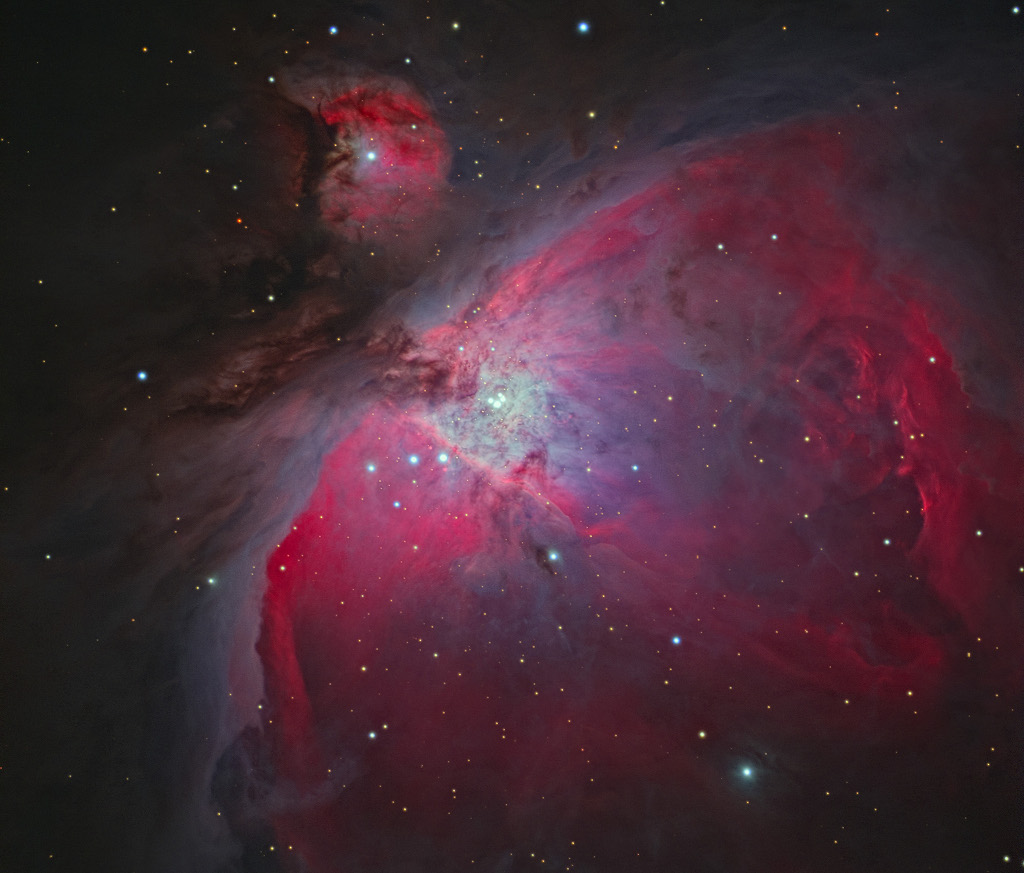
Near the center of this sharp cosmic portrait, at the heart of the Orion Nebula, are four hot, massive stars known as the Trapezium. Tightly gathered within a region about 1.5 light-years in radius, they dominate the core of the dense Orion Nebula Star Cluster. Ultraviolet ionizing radiation from the Trapezium stars, mostly from the brightest star Theta-1 Orionis C powers the complex star forming region's entire visible glow. About three million years old, the Orion Nebula Cluster was even more compact in its younger years and a dynamical study indicates that runaway stellar collisions at an earlier age may have formed a black hole with more than 100 times the mass of the Sun. The presence of a black hole within the cluster could explain the observed high velocities of the Trapezium stars. The Orion Nebula's distance of some 1,500 light-years would make it the closest known black hole to planet Earth. via NASA http://ift.tt/2meZVHQ
Final: Giants 12 Diamondbacks 4. WP: SF M Moore (13-12) LP: ARI A Bradley (8-9) (ESPN)
from ESPN http://ift.tt/1dPqUAn
Final: Diamondbacks 5 Giants 1. WP: ARI R Ray (8-15) LP: SF T Blach (1-0) (ESPN)
from ESPN http://ift.tt/1dPqUAn
Final: Giants 9 Reds 7. WP: SF C Stratton (1-0) LP: CIN T Mahle SV: SF G Kontos (0) (ESPN)
from ESPN http://ift.tt/1dPqUAn
Final: Indians 7 Giants 6. WP: CLE J Martin LP: SF D Law (4-2) SV: CLE A Plutko (0) (ESPN)
from ESPN http://ift.tt/1dPqUAn
Hubble Hones In on a Hypergiant's Home

The super star cluster Westerlund 1, only 15,000 light-years away in our Milky Way neighborhood, hosts one of the largest stars ever discovered. via NASA http://ift.tt/2mr5mVH
NASA's Orion Spacecraft Parachutes Tested at U.S. Army Yuma Proving Ground

Engineers Successfully Test the Parachutes for NASA's Orion Spacecraft at the U.S. Army Yuma Proving Ground via NASA http://ift.tt/2lHA9jX
NASA's Orion Spacecraft Parachute Test at U.S. Army Yuma Proving Ground

Engineers Successfully Test the Parachutes for NASA's Orion Spacecraft at the U.S. Army Yuma Proving Ground via NASA http://ift.tt/2m6ypNA
Women Scientists at NASA in January 1959

January 1959. Women Scientists Lucille Coltrane, Jean Clark Keating, Katherine Cullie Speegle, Doris 'Dot' Lee, Ruth Whitman, and Emily Stephens Mueller. via NASA http://ift.tt/2mYY7ri
A Mass of Viscous Flow Features

Viscous, lobate flow features are commonly found at the bases of slopes in the mid-latitudes of Mars, and are often associated with gullies. via NASA http://ift.tt/2mBvH63
Final: Indians 2 Giants 2. WP: SF D Slania LP: CLE S Morimando (0-0) (ESPN)
from ESPN http://ift.tt/1dPqUAn
Technicians Secure the Protective Covering Around CYGNUS.

In the Space Station Processing Facility high bay at NASA's Kennedy Space Center in Florida, the Orbital ATK CYGNUS pressurized cargo module is secured the KAMAG transporter and the crane has been removed. via NASA http://ift.tt/2lTI4H3
Final: Athletics 6 Giants 1. WP: OAK K Graveman (10-11) LP: SF J Samardzija (12-11) (ESPN)
from ESPN http://ift.tt/1dPqUAn
Hubble Showcases a Remarkable Galactic Hybrid

UGC 12591's classification straddles somewhere between a lenticular and a spiral galaxy. It lies just under 400 million light-years from us in the Pisces–Perseus Supercluster. via NASA http://ift.tt/2mTX87x
Annular Eclipse After Sunrise
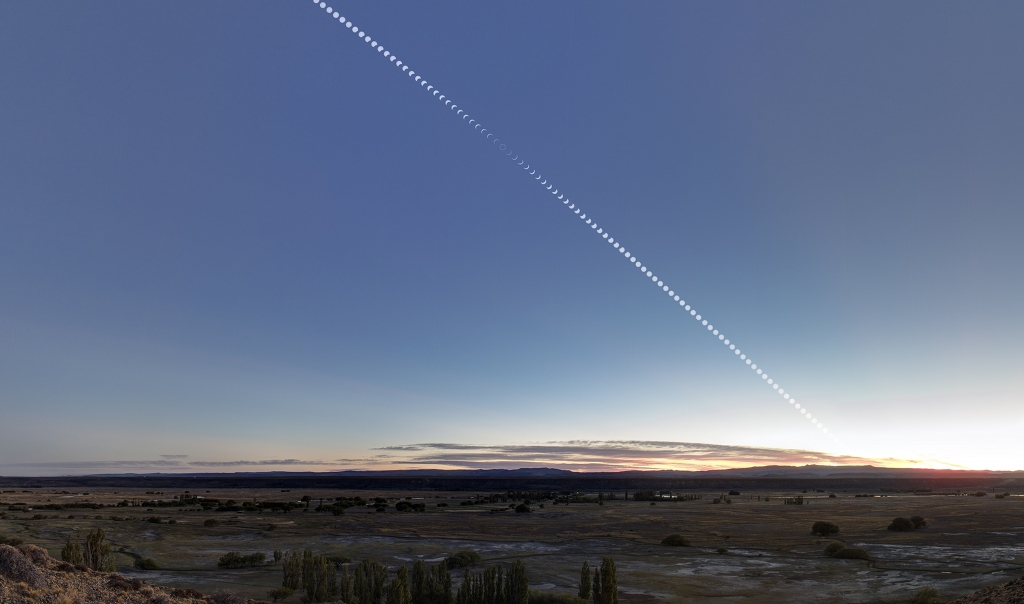
From northern Patagonia, morning skies were clear and blue on Sunday, February 26. This sweeping composite scene, overlooking Hermoso Valle, Facundo, Chubut, Argentina, follows the Sun after sunrise, capturing an annular solar eclipse. Created from a series of exposures at three minute intervals, it shows the year's first solar eclipse beginning well above the distant eastern horizon. An exposure close to mid-eclipse recorded the expected ring of fire, the silhouette of the New Moon only slightly too small to cover the bright Sun. At that location on planet Earth, the annular phase of the eclipse lasted a brief 45 seconds. via NASA http://ift.tt/2lwEkdM
Pearl Young at Langley's Flight Instrumentation Facility, March 1929

In this March 29, 1929 photograph, Pearl I. Young is working in the Langley Memorial Aeronautical Laboratory's Flight Instrumentation Facility (Building 1202). Young was the first woman hired as a technical employee, a physicist at the National Advisory Committee for Aeronautics and the second female physicist working for the federal government. via NASA http://ift.tt/2lx2zsi
A Solar Eclipse with a Beaded Ring of Fire

What kind of eclipse is this? On Sunday, visible in parts of Earth's southern hemisphere, the Moon blocked part of the Sun during a partial solar eclipse. In some locations, though, the effect was a rare type of partial eclipse called an annular eclipse. There, since the Moon is too far from the Earth to block the entire Sun, sunlight streamed around the edges of the Moon creating a "ring of fire". At some times, though, the effect was a rare type of annular eclipse. Then, an edge of the Moon nearly aligned with an edge of the Sun, allowing sunlight to stream through only low areas on the Moon. Called a "Baily's bead" or a "diamond ring", this doubly rare effect was captured Sunday in the feature photograph from Chubut, Argentina, in South America. This summer a total solar eclipse will swoop across North America. via NASA http://ift.tt/2m80EhH
Final: Dodgers 7 Giants 6. WP: LAD R Cash LP: SF G Kontos (3-2) SV: LAD M Johnson (ESPN)
from ESPN http://ift.tt/1dPqUAn
Full-Circle Vista With a Linear Shaped Martian Sand Dune

The left side of this 360-degree panorama from NASA's Curiosity Mars rover shows the long rows of ripples on a linear shaped dune in the Bagnold Dune Field on the northwestern flank of Mount Sharp. via NASA http://ift.tt/2mFkfDS
Subscribe to:
Comments (Atom)